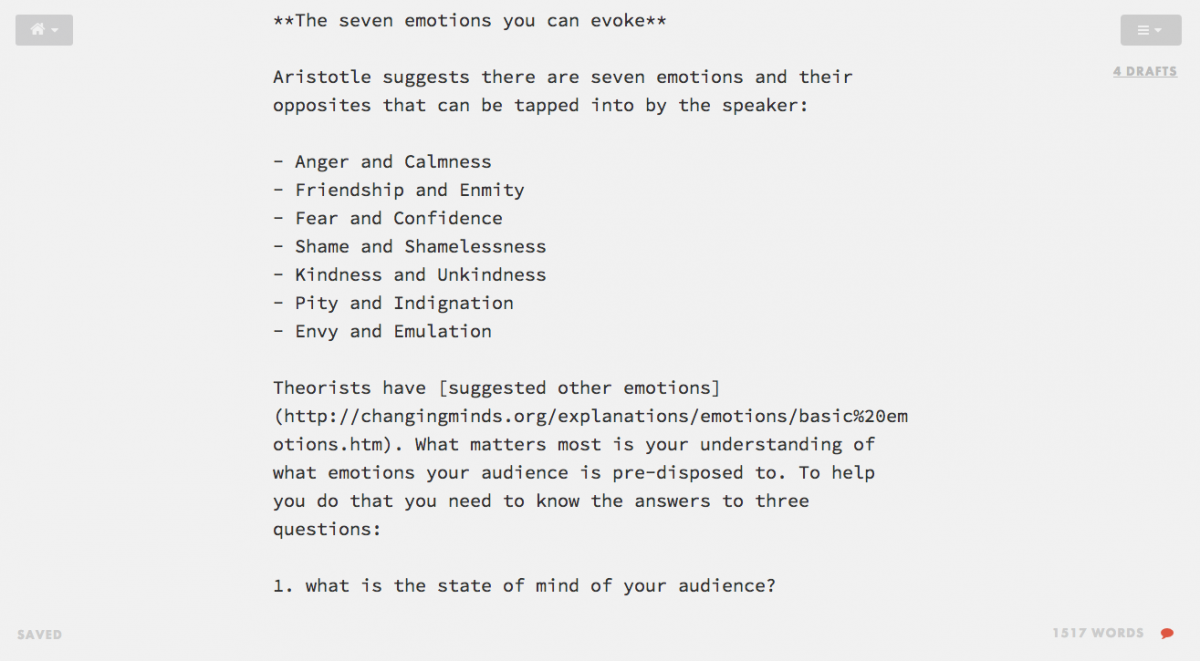Draft is more than a distraction-free writing app. It’s a wonderful way to write, collaborate, and publish. It’s beautiful and easy to use.
Distraction-free writing apps are a dime a dozen.
The first app I used was Writeroom. It was a wonderful innovation. Similar applications emerged and programs like Word, Pages, and Scrivener all added distraction-free writing modes. I have been nonplussed by these additions.
Draft does things differently.
What is Draft?
Draft is a new web application. On the surface appears to be just a distraction-free writing app. It does that well, but it’s much more. Draft is now a tool that’s become a key part of my writing.
A quick rundown of the features:
- Syncing with cloud services like Dropbox, Google Drive, and Evernote;
- Publish to platforms like WordPress, Ghost, Tumblr, and Mailchimp;
- Transcription of YouTube and Vimeo videos, and audio files;
- Version control and collaboration with other authors;
- Writing targets and reports;
- I could go on.
What do I like about Draft?
It’s beautifully presented. Despite its many features it feels like a simple, lightweight app. It imports Word documents and web pages with ease. It publishes directly to my WordPress blog, and exports Word documents, PDFs, HTML and ePub files. Asking people to collaborate and edit is simple. You can either send them an email through Draft or share a URL (much like Google Docs).
A feature I really like is Hemingway Mode — “write now; edit later”. I’ve written before on why separating writing from editing is important. Hemingway Mode encourages that. It disables the delete and backspace keys. It forces you to focus on writing by removing the temptation to edit as you write. When you’re ready to edit, just turn it off.
Nathan Kontny (the developer) is responsive. I was having a problem publishing from Draft to my blog and he replied to my email in less than an hour. It turned out that it was a problem with my blog.
What could be better?
Draft is new and it does have a few weaknesses. There is an option to “simplify” the copy by eliminating passive voice, weak words, and unnecessary text. It’s a good idea, but not very useful in its current form. It recommends sentences that should be removed, but it’s not clear why. Services like After the Deadline and Hemingway App do a better job. Integrating Draft with these services might be the way to go.
I find the version comparison confusing. This might be my own shortcoming, but it’s not clear to me how the proposed edits will affect my draft.
These are minor quibbles.
The final word
I still use Scrivener for my first draft. I write my drafts in chunks and move them around until I have a structure I’m happy with. If Draft offered this it could become the only writing app I use.
It is a wonderful way to write. It looks great in Chrome’s Presentation Mode. All the distractions disappear and the focus is firmly on the writing.
Draft is free. If it’s something you enjoy using, like I do, you can sign up for a monthly or yearly subscription. It’s entirely optional, but $4/month or $40/year is a bargain. As the web evolves, applications will continue to move from the desktop to the web. Draft is another sign of this evolution.
Highly recommended.
